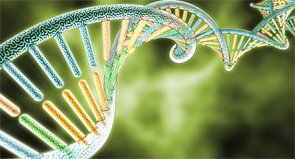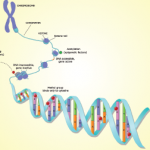
Yang Nan/shutterstock.com
SAN FRANCISCO—As researchers have delved into the genetics behind osteoarthritis (OA), genes that appear to be players in the disease have emerged, but there have also been curveballs thrown, with expectations not always matching up to the genetic realities, an expert said at the 2015 ACR/ARHP Annual Meeting.
The genetic risk of acquiring OA is real: Estimates range from 2- to 8-fold if a family member has OA, compared with a 5- to 10-fold risk for RA and a 3-fold risk for type 2 diabetes.
Ana Valdes, MA, PhD, associate professor and reader in musculoskeletal genetics at the University of Nottingham, said that it was generally thought that genes would line up neatly with extracellular matrix components, signaling pathways, joint inflammation and other aspects of the disease. But the number of genes that has actually been found to be associated with OA has, so far, fallen short of painting such a clear picture.
Genes Associated with Disease
An assessment of 199 OA candidate genes published in 2014 found just two that were significantly linked with the disease—COL11A1 and VEGF, Dr. Valdes said.
Other studies have linked more genes with OA—such as GDF5 in an Asian hip OA cohort and SMAD3 in a Caucasian knee OA cohort.1
Genome-wide association studies have expanded the search for genetic links, but come with a high bar to clear: P values have to be less than 5 x 10(-8), requiring either extremely large sample sizes or big genetic effects, Dr. Valdes said.
These studies have yielded several hits, but some have come with twists: the DVWA gene—a clear hit in its Asian, knee OA population and thought to be associated with the tubulin-binding in cartilage—has not been reproducible in studies on Caucasian patients, even in very well-powered studies, Dr. Valdes said.
“It just seems that genetic contribution to genetic arthritis is different in the two ethnic groups,” she said.
Two newer genes that have been recently found in hip OA—DOT1L, involved in Wnt signaling, and IGFBP3, involved in cartilage breakdown—seem to fit in well with what is known about the biology of the disease, Dr. Valdes said.
Epigenetic studies have also been taking off, she said. A study of 25 OA patients and 20 controls, and involving 27,000 DNA methylation probes, found different methylation patterns between the two groups, and a genome-wide expression analysis found a cluster of OA patients with a distinct pattern of gene expression characterized by an increased inflammatory response.2
Also, she said, comparisons of methylation patterns between knee OA and hip OA have found differences, confirming that the diseases “have some common pathways but some strong differences in terms of pathogenesis.”
Beyond Genes
Tim Spector, MD, professor of epidemiology at King’s College London, said that when it comes to personalized medicine—the ultimate therapeutic goal—genome-wide association studies are not particularly helpful, having little use in actual diagnosis and prediction. But used with intermediate or molecular phenotypes—immunomics, metabolomics or other “-omics”—the effects can be more meaningful.
The FTO gene studied in OA, for example, has a small effect in GWAS studies, but once the mechanism is understood, steps in gene editing can be taken to have a large effect—in the case of FTO, on the size and type of adipocytes.
“If you can understand that mechanistically, you can make a very big effect experimentally,” Dr. Spector said. “So I think that’s the real important message from this stuff is, don’t get put off by these tiny effect sizes or the fact that you need 10,000 or 20,000 people to find them.”
Dr. Spector—the founder of Twins UK, a database on identical twins and one of the world’s largest collections of genotypic and phenotypic information—said that epigenetics’ role, including in OA and other rheumatic diseases, is gradually being seen as bigger than previously thought. For events such as heart disease, depression and cancer, the concordance is less than 50/50 if your identical twin has it, the data show.
A worm, he reminded the audience, has more genes than a human being.
“Perhaps, we shouldn’t give genes quite as much credence as we have done in the last 10 years,” he said. “There’s much more to life than just having a few genes. It’s what you do with them.”
5mC
Nidhi Bhutani, PhD, professor of orthopaedic surgery at Stanford University, said researchers are making strides in understanding what appears to be an important role of the de-methylation of 5-methylctyosine (5mC)—a DNA cytosine nucleotide that has been modified with the addition of a methyl group. In the epigenetics field, excitement has been stirred by the emergence of the role of 5-hydroxymethylcytosine (5hmC), a product of that de-methylation. Researchers have found that 5hmC appears to be linked to gene expression.
At Stanford, researchers have found that 5hmC is increased in OA chondrocytes and that it is not simply a product of aging.3,4 Researchers have also compared results of OA susceptibility gene studies with results from de-methylation studies and found a large number of genes that overlap.5,6,7
The de-methylation process and the gain of 5hmC might offer a therapeutic window, she said.
Recent findings raise the possibility of, “whether by modulating the DNA methylation and de-methylation dynamics, we can actually change or modulate OA pathology.”
“A broader idea is just to also think about the OA epigenome—the mapping of the OA epigenome—even beyond DNA methylation changes, and to figure out the target genes of these genomic changes and to identify whether the modulation of the OA epigenome, per se, can be a new therapeutic strategy for OA.”
Thomas R. Collins is a medical writer based in Florida.
Second Chance
If you missed this session, it’s not too late. Catch it on SessionSelect.
References
- Tsezou A. Osteoarthritis year in review 2014: Genetics and genomics. Osteoarthritis Cartilage. 2014 Dec;22(12):2017–2024.
- Fernandez-Tajes J, Soto-Hermida A, Vazquez-Mosquera ME, et al. Genome-wide DNA methylation analysis of articular chondrocytes reveals a cluster of osteoarthritic patients. Ann Rheum Dis. 2014 Apr;73(4):668–677.
- Taylor SE, Smeriglio P, Dhulipala L, et al. A global increase in 5-hydroxymethylcytosine levels marks osteoarthritic chondrocytes. Arthritis Rheumatol. 2014 Jan;66(1):90–100.
- Taylor SE, Li YH, Wong WH, et al. Genome-wide mapping of DNA hydroxymethylation in osteoarthritic chondrocytes. Arthritis Rheumatol. 2015 May;67(8):2129–2140.
- Jeffries MA, Donica M Baker LW, et al. Genome-wide DNA methylation study identifies significant epigenomic changes in osteoarthritic cartilage. Arthritis Rheumatol. 2014 Oct;66(10):2804–2815.
- Rushton MD, Reynard LN, Barter MJ, et al. Characterization of the cartilage DNA methylome in knee and hip osteoarthritis. Arthritis Rheumatol. 2014 Sep;66(9):2450–2460.
- Den Hollander W, Ramos YF, Bos SD, et al. Knee and hip articular cartilage have distinct epigenomic landscapes: implications for future cartilage regeneration approaches. Ann Rheum Dis. 2014 Dec;73(12):2208–2212.
